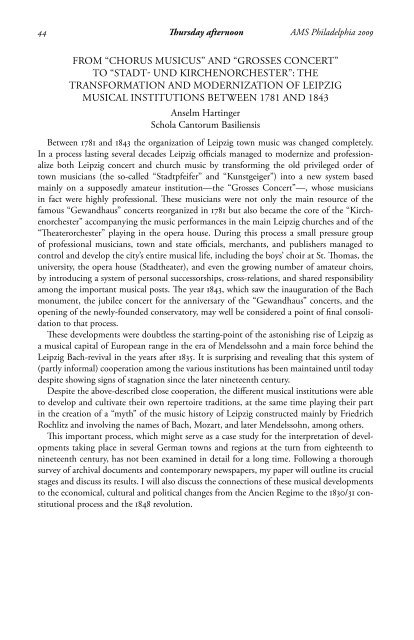AMS Philadelphia 2009 Abstracts - American Musicological Society
AMS Philadelphia 2009 Abstracts - American Musicological Society
AMS Philadelphia 2009 Abstracts - American Musicological Society
Create successful ePaper yourself
Turn your PDF publications into a flip-book with our unique Google optimized e-Paper software.
44 Thursday afternoon <strong>AMS</strong> <strong>Philadelphia</strong> <strong>2009</strong><br />
FROM “CHORUS MUSICUS” AND “GROSSES CONCERT”<br />
TO “STADT- UND KIRCHENORCHESTER”: THE<br />
TRANSFORMATION AND MODERNIZATION OF LEIPZIG<br />
MUSICAL INSTITUTIONS BETWEEN 1781 AND 1843<br />
Anselm Hartinger<br />
Schola Cantorum Basiliensis<br />
Between 1781 and 1843 the organization of Leipzig town music was changed completely.<br />
In a process lasting several decades Leipzig officials managed to modernize and professionalize<br />
both Leipzig concert and church music by transforming the old privileged order of<br />
town musicians (the so-called “Stadtpfeifer” and “Kunstgeiger”) into a new system based<br />
mainly on a supposedly amateur institution—the “Grosses Concert”—, whose musicians<br />
in fact were highly professional. These musicians were not only the main resource of the<br />
famous “Gewandhaus” concerts reorganized in 1781 but also became the core of the “Kirchenorchester”<br />
accompanying the music performances in the main Leipzig churches and of the<br />
“Theaterorchester” playing in the opera house. During this process a small pressure group<br />
of professional musicians, town and state officials, merchants, and publishers managed to<br />
control and develop the city’s entire musical life, including the boys’ choir at St. Thomas, the<br />
university, the opera house (Stadtheater), and even the growing number of amateur choirs,<br />
by introducing a system of personal successorships, cross-relations, and shared responsibility<br />
among the important musical posts. The year 1843, which saw the inauguration of the Bach<br />
monument, the jubilee concert for the anniversary of the “Gewandhaus” concerts, and the<br />
opening of the newly-founded conservatory, may well be considered a point of final consolidation<br />
to that process.<br />
These developments were doubtless the starting-point of the astonishing rise of Leipzig as<br />
a musical capital of European range in the era of Mendelssohn and a main force behind the<br />
Leipzig Bach-revival in the years after 1835. It is surprising and revealing that this system of<br />
(partly informal) cooperation among the various institutions has been maintained until today<br />
despite showing signs of stagnation since the later nineteenth century.<br />
Despite the above-described close cooperation, the different musical institutions were able<br />
to develop and cultivate their own repertoire traditions, at the same time playing their part<br />
in the creation of a “myth” of the music history of Leipzig constructed mainly by Friedrich<br />
Rochlitz and involving the names of Bach, Mozart, and later Mendelssohn, among others.<br />
This important process, which might serve as a case study for the interpretation of developments<br />
taking place in several German towns and regions at the turn from eighteenth to<br />
nineteenth century, has not been examined in detail for a long time. Following a thorough<br />
survey of archival documents and contemporary newspapers, my paper will outline its crucial<br />
stages and discuss its results. I will also discuss the connections of these musical developments<br />
to the economical, cultural and political changes from the Ancien Regime to the 1830/31 constitutional<br />
process and the 1848 revolution.










